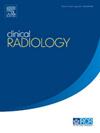Prediction of Ki-67 expression in hepatocellular carcinoma with a computed tomography (CT) extracellular volume-derived nomogram
IF 2.1
3区 医学
Q2 RADIOLOGY, NUCLEAR MEDICINE & MEDICAL IMAGING
引用次数: 0
Abstract
AIM
To investigate and verify the ability of the extracellular volume fraction (fECV) during the delayed computed tomography (CT) phase to noninvasively predict the preoperative Ki-67 expression level in hepatocellular carcinoma (HCC).
MATERIALS AND METHODS
The clinical and imaging data of 94 patients with HCC, pathologically diagnosed according to preoperative enhanced CT at our hospital, were retrospectively analysed The patients were randomly divided into a training group (66 patients) and a validation group (28 patients) at a 7:3 ratio. Univariable and multivariable logistic regression analyses were used to identify clinical risk factors, which were integrated with the fECV model to generate a joint nomogram model, whose performance was assessed using the Akaike information criterion (AIC), area under the curve (AUC), accuracy, sensitivity, and specificity. The clinical utility of the models was assessed via decision curve analysis (DCA).
RESULTS
In multivariate analysis, tumour capsule (OR = 0.178, P = 0.013) and fECV (OR = 1.282, P < 0.001) were independent predictors of high Ki-67 levels. The AUCs of the joint nomogram model constructed from these predictors and the fECV model were greater than those of the fECV model alone in the training and test sets, but the differences were not significant (P > 0.05, DeLong test). Moreover, the nomogram model had the lowest AIC value (21.09), indicating that it was the best model, and showed good clinical utility in both the training and validation sets.
CONCLUSION
The combined nomogram model based on the delayed-phase fECV has potential value in predicting individualised preoperative Ki-67 expression levels in HCC patients.
用计算机断层扫描(CT)细胞外体积衍生图预测Ki-67在肝细胞癌中的表达
目的探讨并验证延迟CT期细胞外体积分数(fECV)对肝细胞癌(HCC)术前Ki-67表达水平的无创预测能力。材料与方法回顾性分析我院术前增强CT病理诊断的94例HCC患者的临床及影像学资料,按7:3的比例随机分为训练组(66例)和验证组(28例)。采用单变量和多变量logistic回归分析识别临床危险因素,并将其与fECV模型相结合,生成联合nomogram模型,采用赤池信息准则(AIC)、曲线下面积(AUC)、准确性、敏感性和特异性对其进行评价。通过决策曲线分析(DCA)评估模型的临床效用。结果在多因素分析中,肿瘤胶囊(OR = 0.178, P = 0.013)和fECV (OR = 1.282, P <;0.001)是高Ki-67水平的独立预测因子。在训练集和测试集上,由这些预测因子和fECV模型构建的联合nomogram模型的auc均大于单独使用fECV模型的auc,但差异不显著(P >;0.05, DeLong检验)。其中,nomogram模型AIC值最低(21.09),为最佳模型,在训练集和验证集均具有较好的临床应用价值。结论基于延迟期fECV的联合nomogram模型在预测HCC患者术前Ki-67表达水平方面具有潜在价值。
本文章由计算机程序翻译,如有差异,请以英文原文为准。
求助全文
约1分钟内获得全文
求助全文
来源期刊

Clinical radiology
医学-核医学
CiteScore
4.70
自引率
3.80%
发文量
528
审稿时长
76 days
期刊介绍:
Clinical Radiology is published by Elsevier on behalf of The Royal College of Radiologists. Clinical Radiology is an International Journal bringing you original research, editorials and review articles on all aspects of diagnostic imaging, including:
• Computed tomography
• Magnetic resonance imaging
• Ultrasonography
• Digital radiology
• Interventional radiology
• Radiography
• Nuclear medicine
Papers on radiological protection, quality assurance, audit in radiology and matters relating to radiological training and education are also included. In addition, each issue contains correspondence, book reviews and notices of forthcoming events.
 求助内容:
求助内容: 应助结果提醒方式:
应助结果提醒方式:


